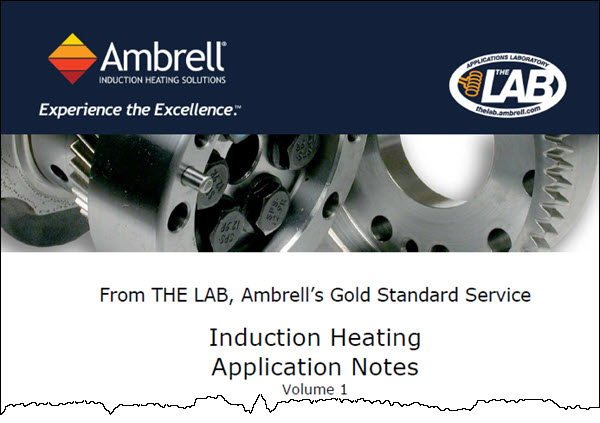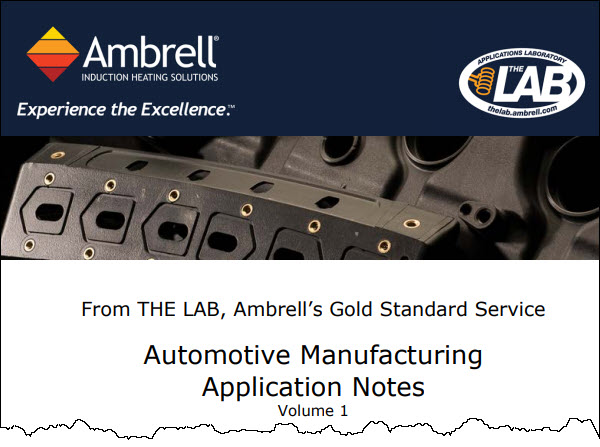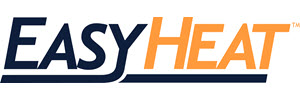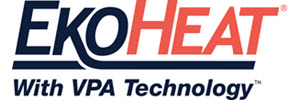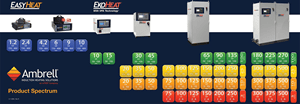Induction in Automotive Manufacturing
- Home
- How It's Used
- Automotive Applications
How is induction heating used in automotive manufacturing?
For decades, Ambrell has been partnering with the world’s largest automotive OEMs, integrators and Tier 1 and 2 suppliers to deliver superior induction heating solutions.
Induction generates an electromagnetic field in a work coil that induces currents in the conductive material of a workpiece placed within or near the coil. Friction from these currents elevates the temperature of the workpieces to be heated.
Benefits of Induction in Automotive Manufacturing
Process repeatability, accuracy, energy efficiency and speed are four hallmarks of induction heating for virtually any application. Additionally, induction heating delivers heat to the targeted part, not the atmosphere around it, so there is no risk of distortion.
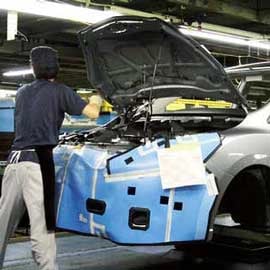
Automotive-Manufacturing-Related Application Notes
Open panels to select from our libraries of notes
-
Bonding
 Bonding Adhesive to a Steel Washer (Automotive)
Bonding Adhesive to a Steel Washer (Automotive)Bonding with induction heated a steel washer to the target temperature to enabling adhesive curing; it will be part of an automated process for an automotive industry application
 Bonding Plastic with a Steel Gasket
Bonding Plastic with a Steel GasketInduction bonding enables rapid heating, can easily be integrated into the client's manufacturing process due to modest space requirements and delivers a highly repeatable process.
 Debonding inserts for manifold
Debonding inserts for manifoldA four-turn two-position helical coil is used to debond the inserts from the plastic. The coil is placed against the manifold and power is applied to the two inserts for 15 seconds to soften the plastic...
 Sealing a Nylon Shell for a fuel vapor Assembly
Sealing a Nylon Shell for a fuel vapor AssemblyFilter modules are assembled on the fixture with ring gasket. Pressure is applied to the modules, modules are rotated and induction heating is started. After 10-12 seconds, heating is halted and the modules are removed from the fixture.
 Bonding Rubber Gaskets to a Steel Gas Intake Manifold
Bonding Rubber Gaskets to a Steel Gas Intake ManifoldTwo two-turn pancake coils are specially contoured to the the shape of the steel assembly to produce uniform heat in the gasket areas.
 Debond rubber seal from steel oil seal ring
Debond rubber seal from steel oil seal ringInduction heating provides highly accurate, fast, more efficient placement of heat, no effect to surrounding components
 Bonding Automotive Trim Vinyl Covering
Bonding Automotive Trim Vinyl CoveringHeating to 500 °F is accomplished through the use of the unique coil; molding is continuously processed at a rate over 20 feet per minute.
 Press-Bonding Metal Clips Into Sealers
Press-Bonding Metal Clips Into SealersTo heat metal clips and press-bond them into rubber seals. The metal needs to be heated to 250 °F to 350 °F with a cycle time not exceeding 3 seconds
 Bonding Steel Wire; Rubber Molding
Bonding Steel Wire; Rubber MoldingTo heat steel wire embedded in an automotive rubber molding. Testing from THE LAB confirmed the feasibility of the heating process for the customer.
-
Brazing
 Brazing aluminum adaptors to aluminum tubes
Brazing aluminum adaptors to aluminum tubesTo increase production, a multi-position coil was recommended so multiple parts could be heated while maintaining a cycle time of 55 seconds, delivering consistent joint quality, which a torch often doesn't deliver.
 Brazing steel flange and shaft
Brazing steel flange and shaftInduction brazing is a repeatable process that isn't as labor intensive as a flame often is. The process can heat the assembly rapidly and more energy-efficiently than a torch without the safety risks that come with an open flame
 Brazing a steel tube and fitting (automotive valve)
Brazing a steel tube and fitting (automotive valve)Customer's client was unhappy with the results from MIG welding, which drove them to look at induction as an alternative process. Induction heating proved to be a fast, repeatable heating method for the application...
 Heat a compacted litz wire bundle for stripping
Heat a compacted litz wire bundle for strippingA three turn helical coil is used for the wire stripping process. The litz wire bundle is placed in the coil for 3 seconds to strip the lacquer 0.75 (19mm) from the end of the bundle. The wire bundle is then scraped with a metal brush to remove the burnt lacquer...
 Heat aluminum for brazing an automotive assembly
Heat aluminum for brazing an automotive assemblyA multi turn pancake coil is used to heat the joint between the aluminum tubing and boss. The joint heats to temperature in 1.5 minutes and the braze ring melts forming a clean brazed joint.
 Brazing automotive tube assemblies
Brazing automotive tube assembliesA four turn split helical coil is used to heat the steel assembly to 1400 °F (760 °C) for 85 seconds. The coil design allows for the steel fitting to expand away from the steel tube which allows braze to flow through the joint.
 Braze a Copper Tube and Brass Fitting
Braze a Copper Tube and Brass FittingHow to braze copper using a custom-designed single position multi-turn helical coil built to generate the required heating for the copper brazing application.
 Brazing Oil Suction Assembly with Copper Ring
Brazing Oil Suction Assembly with Copper Ring To heat an oil suction assembly (steel tubing and filter cap) to 1,850 °F (1010 °C) within 15 seconds for a brazing application.
 Brazing an Aluminum Tube Assembly
Brazing an Aluminum Tube AssemblyA custom-designed single position multiple-turn pancake coil was built to generate the required heating for this brazing application. Initial tests were conducted to optimize power delivery to the assembly
-
Curing
 Curing a coating; both sides aluminum piston
Curing a coating; both sides aluminum pistonA three-turn channel coil 19 in (48.26 cm) long is used to anneal 4 pistons running though the coil with a distance of 6 in (15.24 cm) between centers.
 Curing plastisol adhesive on an aluminum filter assembly
Curing plastisol adhesive on an aluminum filter assemblyA four turn helical coil is used to cure the plastisol adhesive. One filter end cap is filled with adhesive, attached to the filter and heated 90 seconds to cure the adhesive.
 Bonding Rear View Mirror Brackets to Windshield Glass
Bonding Rear View Mirror Brackets to Windshield GlassA unique four-over-four double wound pancake coil is used for the bonding application.
 Curing Adhesive on Steel Motor Shaft for Bonding
Curing Adhesive on Steel Motor Shaft for BondingA complex two coil system, shield and stud systems used to provide proper axial alignments of the shaft & coil while allowing the fixture to be open for removal of the shaft.
 Heating Aluminum Auto Trim for Adhesive Curing
Heating Aluminum Auto Trim for Adhesive CuringTo heat various sizes of aluminum auto trim to 500 °F (260 °C) at a rate of 30 ft. (9.1m) per minute for curing an adhesive.
-
Heat Staking
 Heating stainless steel inserts
Heating stainless steel insertsInduction offers dramatically faster heating when compared to ultrasonics; faster heating means there is the potential to dramatically increase production rates with a highly repeatable and easy-to integrate processes.
Innovation: Ambrell's Applications Lab was able to solve a problem that a competitor couldn't solve, which is a key benefit when purchasing induction solutions from Ambrell
 Metal-to-plastic insertion of threaded magnetic steel inserts
Metal-to-plastic insertion of threaded magnetic steel insertsOutdated equipment and poor responsiveness drove this customer to a new vendor who could help them with new or improved processes for new or enhanced solutions
 Inserting a piston stop & o-ring (oil pump)
Inserting a piston stop & o-ring (oil pump)Induction heating provides increased production speed, simpler tooling for customer, hands-free heating that involves no operator skill for manufacturing
 Bonding electric motor shaft to nylon face fan
Bonding electric motor shaft to nylon face fanInduction heating provides hands-free heating that involves no operator skill for manufacturing, only the metal shaft is heated so the motor is not affected, increased production due to rapid heating, decreased failure rate, originally used glue which ran into motor and caused failure and stronger bond
 Heating Four Inserts Simultaneously
Heating Four Inserts SimultaneouslyThe brass inserts are to be heated prior to insertion into a plastic automotive sub assembly
Heating is to be accomplished within 5 seconds, and can be done in a helical coil since pick and place manufacturing is employed.
 Inserting Steel Studs into a Plastic Tail Light
Inserting Steel Studs into a Plastic Tail LightTo heat threaded steel studs for insertion into a plastic tail-light assembly at 450 °F.
 Metal-to-Plastic Insertion with a Steel Insert
Metal-to-Plastic Insertion with a Steel InsertThe power was turned on for five seconds and the part was monitored during heating and for 15 seconds after.
To heat steel inserts to be placed into a plastic frame. The end product is an automotive part.
 Heating a Steel Pin for Fan Insertion
Heating a Steel Pin for Fan InsertionAn EASYHEAT and its workhead require a minimal footprint, saving the client valuable floor space compared to heating alternatives
-
Heating (Others)
 Heating an Aluminum Tube for Bending
Heating an Aluminum Tube for BendingInduction does not present an open flame into the work environment like a torch, resulting in a safer working environment
 Preheating a steel automotive transaxle (welding)
Preheating a steel automotive transaxle (welding)The steel axle was painted with temperature indicating paint and a thermocouple was attached to the part.
 Pre-heating aluminum wheels (spray painting)
Pre-heating aluminum wheels (spray painting)This spray painting application requires pre-heating the material. Additionally, there is a requirement that the material must not cool below a certain target temperature prior to the spray.
 Heating lead battery terminal for removal (recycling)
Heating lead battery terminal for removal (recycling)A single turn helical coil is used for this heating application. The lead terminal is placed inside the coil and is heated for 20 seconds.
 Heating a motor prior to adding an injection molded part
Heating a motor prior to adding an injection molded partInduction heating enables quicker process times with increased production rates versus a gas-fired oven. Ovens require long heat-up and cool-down times
 Heating steel liners (engine head)
Heating steel liners (engine head)Precise direct heat to disengage the aluminium quickly and cleanly. The aluminium casing is recycled and reused thereby reducing scrap and cutting costs.
 Heat automotive seat springs to powder coat
Heat automotive seat springs to powder coatEven heating of the spring before dipping provides uniform flow and provides consistent thickness of the nylon coating
 Heating of steel rivet ends (turbines)
Heating of steel rivet ends (turbines)Heating steel rivets prior to head forming
 Heat the end of catalytic converter for weld testing
Heat the end of catalytic converter for weld testingHeat the end of lorry catalytic converter exhaust system. The assembly must be held at target temperature for 200 hours, whilst the assembly is vibrated to test the weld strength
 Heating Automotive Battery Cables for Adhesive Melting
Heating Automotive Battery Cables for Adhesive MeltingTemperature indicating paint was applied to the parts, and it took 10 seconds to heat the various styles of the part to the targeted temperature. This testing achieved the client's time and quality objectives.
 Heating an Engine Valve Head for Stress Testing
Heating an Engine Valve Head for Stress TestingTo heat the face of an engine valve head to 900 °F and maintain the temperature for an extended time, high temperature stress test.
 Pre-heating a Truck Axle Seam for Welding
Pre-heating a Truck Axle Seam for WeldingTo pre-heat the seam of a truck axle to over 300 °F within 15 seconds for a welding application and maintain temperature within the welding zone
 Preheating Steel Laminate Parts
Preheating Steel Laminate PartsThe c-lams are inserts for an automotive industry application. In production the robotic pick-and-place will occur for plastic overmolding after heating by induction.
 Preheating Rod Assemblies for Welding
Preheating Rod Assemblies for WeldingThe client had been using torches for preheating. However, due to process improvements thanks to new automation in their facility, torch heating became too slow. This resulted in a backlog that kept them from maximizing their throughput.
 Pre-heating a steel transaxle tube (welding)
Pre-heating a steel transaxle tube (welding)Induction heating achieves an identical result consistently, and is a more efficient heating method, each of which are advantage over torch heating
 Preheating Steel Tubes Prior to Bonding
Preheating Steel Tubes Prior to BondingTo heat steels tubes for a bonding application; the end product is a bushing for large trucks. Induction would replace an oven for this client.
-
Shrink Fitting
 Shrink fitting an automotive aluminum motor housing
Shrink fitting an automotive aluminum motor housingInduction shrink-fitting is fast, presents significant energy savings over an electric oven, requires a more modest footprint than an oven and can be easily integrated into an automated process
 Shrink Fitting A Gear to a Shaft
Shrink Fitting A Gear to a ShaftThe customer was using a torch, which can lead to inconsistent part quality. Induction's precise heating means the client can count on consistent results in their process
 Shrink Fitting an Aluminum Motor Housing
Shrink Fitting an Aluminum Motor HousingThe customer was using a cold press, but it was creating part defects. This was resolved with induction heating: the process took just two minutes compared to 40 minutes and they were able to achieve their targeted production rate.
 shrink-fitting a carbide ring into a valve seat
shrink-fitting a carbide ring into a valve seatA three turn helical coil is used to heat the steel valve seat. The steel valve seat is placed in the coil and heated for 50 seconds to enlarge the center hole & drop the carbide ring in for the shrink-fitting process.
 Shrink-fitting auto turbo charger impeller blades onto an aluminum shaft
Shrink-fitting auto turbo charger impeller blades onto an aluminum shaftInduction heating provides repeatable results, reduced cycle time, lower consumables cost and even distribution of heating
 Shrink fitting aluminum pulley to insert inner bearing
Shrink fitting aluminum pulley to insert inner bearing A three turn helical coil is used to heat the aluminum pulley. The pulley is heated to 464 °F (240 °C) in 20 seconds to expand the inner diameter and then the inner bearing is inserted to form the completed part.
 shrink-fitting an assembled wrist pin into a connecting rod
shrink-fitting an assembled wrist pin into a connecting rodInduction heating provides more accurate control of heat vs a flame burner, it heats only the knuckle, not the whole part, it prevents discoloring due to lower temperature used and increases productivity due to repeatability & ease of operation. A foot pedal & timer is used.
 Shrink fit a motor shaft and roller
Shrink fit a motor shaft and rollerProcessing with induction heat saves power and time. The complete tube does not have to reach the desired temperature as it does when heating with an oven. Being able to selectively heat a zone allows for a much quicker transfer of heat.
 Shrink Fitting Cam Shaft Gears
Shrink Fitting Cam Shaft GearsTo heat aluminum and steel camshaft gears to over 500 °F within 4 minutes for a shrink fitting application.
 Shrink Fitting Magnetic Steel Pistons
Shrink Fitting Magnetic Steel PistonsUsing induction for shrink-fitting magnetic steel pistons onto a chrome shaft; the client was using an unreliable handheld induction system and wanted a higher quality induction shrink-fitting solution.
Our Systems for automotive manufacturing with Induction
Headline
Add your content here.
Headline
Add your content here.
Headline
Add your content here.
Headline
Add your content here.
AMBRELL CORPORATION
1655 Lyell Avenue
Rochester, NY 14606
United States
![]() Directions
Directions
T: +1 585 889 9000
F: +1 585 889 4030
Contact Sales
Contact Orders
Contact Service
AMBRELL B.V.
Holtersweg 1
7556 BS Hengelo
The Netherlands
![]() Directions
Directions
T: +31 880 150 100
F: +31 546 788 154
Contact Sales
Contact Orders
Contact Service
AMBRELL Ltd.
Front Suite, 1st Floor, Charles House
148-149 Gt Charles Street
Birmingham, B3 3HT
United Kingdom
T: +44 1242 514042
F: +31 546 788 154
Contact Sales
Contact Orders
Contact Service


 Heating brass inserts
Heating brass inserts Brass Inserts
Brass Inserts Heat Staking Steel Parts
Heat Staking Steel Parts